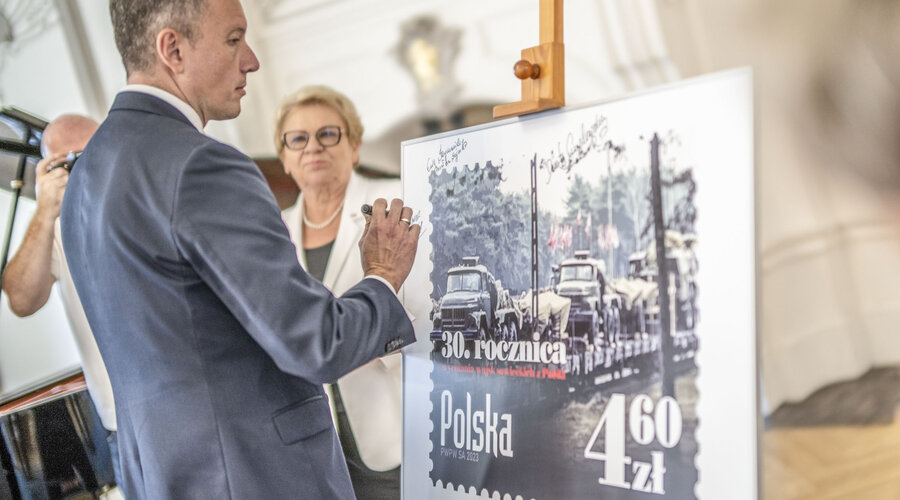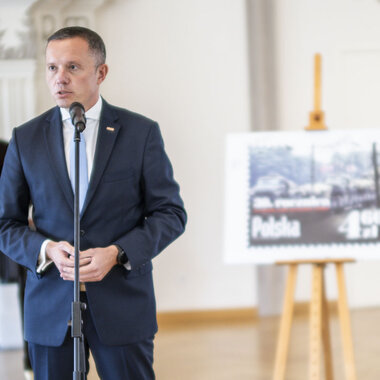Poczta Polska: A unique stamp commemorating the 30th anniversary of the withdrawal of Soviet troops from Poland
This year we are celebrating the 30th anniversary of the final withdrawal of Soviet troops from Poland. Poczta Polska issued a special commemorative stamp to commemorate this event.
The stamp shows railway wagons transporting Soviet military vehicles. Along the lower edge of the stamp is the inscription: Poland and a value designation: PLN 4.60, and in the left-hand corner the inscription reads: 30th anniversary of the withdrawal of Soviet troops from Poland. The stamp was printed in an edition of 120,000 pieces. The applicant for the issue was Tomasz Zdzikot, the then president of Poczta Polska.
– This is a unique moment in our history that symbolizes the country's freedom, sovereignty and independence. For Poland, this is a moment related to history, but also to our national identity - the country has regained full control over its territory and the fate of its citizens. It was thanks to the determination and courage of the nation that this significant success in Polish history was achieved. I would like this stamp to express our respect for all those who contributed to the liberation of Poland from foreign influence. Let this publication become a symbol of unity, patriotism and readiness to defend our values - said Krzysztof Falkowski, President of the Management Board of Poczta Polska.
– The anniversary of the Soviet troops leaving Legnica is a moment full of symbolism for our homeland. Poland's history is full of moments of trials and triumphs on the way to full sovereignty and independence. Dolny Śląsk, the Copper belt and Legnica remember perfectly the events of 30 years ago. The stamp issued today highlights their importance to past and future generations of Poles. We remember and will continue to remember September 1993, not to look back, but to continue our efforts and activities to build a Poland that is secure both economically and militarily. Especially now, when the war drama is taking place behind our eastern border, in Ukraine, said Tomasz Zdzikot, president of the management board of KGHM Polska Miedź S.A. The copper company in Legnica has its oldest branch, the Legnica Copper Smelter. The plant celebrates its 70th anniversary this year.
The 30th anniversary of the withdrawal of Soviet troops from Poland
Since the end of the Second World War, tens of thousands of Soviet Army soldiers were still stationed on Polish territory for a long time, forming the so-called Northern Army Group. Their units were stationed in more than 70 towns and their headquarters were located in Legnica. It is worth remembering that these troops took an active part in fighting the Polish independence underground, i.e. the Żołnierze Wyklęci (Cursed Soldiers), from the very beginning. For the first 10 years, their stay in Poland was solely the result of a decision made by Stalin. It was not until 1956 that an agreement was signed in Warsaw, giving legal status to the Soviet troops that were to be 'temporarily stationed in Poland'. During their presence, which lasted nearly half a century, more than 600 Polish citizens died as a result of traffic accidents and accidental or intentional gunshots.
The first troops left the territory of Poland as early as April 1991. More than a year later, a 'protocol on the settlement of property, financial and other matters related to the withdrawal of troops of the Russian Federation from the territory of Poland' was signed. Pursuant to it, the Russians withdrew all combat units by October 1992, and on September 17, 1993, the last of their units. A day later, the last group of Russian officers left the Eastern Railway Station in Warsaw.
Losses after the withdrawal of Soviet troops
Soldiers of the Northern Army Group, leaving the territory of Poland, plundered and devastated huge property. The costs of reclamation of the environment degraded by the Russians amounted to over PLN 5 billion. Another PLN 6 billion are losses directly related to Northern Army Group's stay in Poland.
Indeed, the Soviets used a total of 70,000 hectares of land, 60,000 of which were used as training grounds, equipped with 13 airfields. Over 64 km of railway sidings and 3 km of quays in the two harbour basins were also at the disposal of the Russians. They also leased 1,200 residential buildings and approximately 2.5 thousand barrack buildings.










